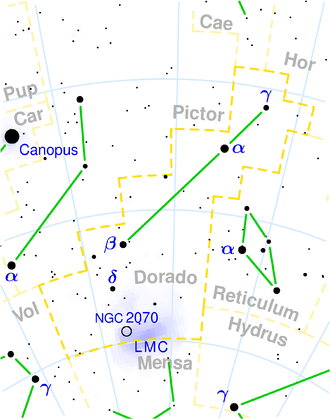VFTS 682
|
Star VFTS 682 |
|||||
|---|---|---|---|---|---|

|
|||||
| VFTS 682 in the Large Magellanic Cloud | |||||
| AladinLite | |||||
|
Observation dates equinox : J2000.0 , epoch : J2000.0 |
|||||
| Constellation | Swordfish | ||||
| Right ascension | 05 h 38 m 55.52 s | ||||
| declination | -69 ° 04 ′ 26.8 ″ | ||||
| Apparent brightness | 16.08 mag | ||||
| Typing | |||||
| B − V color index | 0.58 | ||||
| U − B color index | −0.35 | ||||
| Spectral class | WN5h | ||||
| Astrometry | |||||
| Physical Properties | |||||
| Dimensions | 150 M ☉ | ||||
| Luminosity |
3.16 million L ☉ |
||||
| Effective temperature | 52,200 ± 2500 K | ||||
| Age | 1–1.4 million a | ||||
|
Other names and catalog entries |
|||||
|
|||||
VFTS 682 is one of the most massive stars currently known. Its mass is currently around 150 M ☉ , although its original mass was probably 120–210 M ☉ . VFTS 682 is a Wolf-Rayet star of the spectral class WN5h.
VFTS 682 is located approximately 30 pc northeast of the super star cluster R136 , which lies in the Tarantula Nebula (NGC 2070) in the Large Magellanic Cloud .
Its isolated position and its large mass raise the question of where the star was formed: at its present location or in the star cluster R136 .
Speak for the development on site:
- the isolated location
- the slight movement
- the lack of a bow shock
On the other hand, it is usually assumed that such massive stars can actually only form in star clusters . There you can z. B. arise from the merging of the stars of a binary star system, as simulations show.
Surname
The first part of the name VFTS is the name of the project " V LT F LAMES T arantula south of urvey" ESO derived at the stars in the Tarantula Nebula in the Large Magellanic Cloud were examined. The second part of the name 682 is the sequential number of the star in the context of this investigation.
See also
Web links
- ESO: Radiant star loner discovered + photos and animation - May 25, 2011
Individual evidence
- ↑ a b c UCAC4 105-014417. In: SIMBAD . Center de Données astronomiques de Strasbourg , accessed September 10, 2018 .
- ↑ a b c d Joachim M. Bestelehner, Jorick S. Vink, G. Gräfener, F. Najarro et al .: The VLT-FLAMES Tarantula Survey III: A very massive star in apparent isolation from the massive cluster R136 * . In: Astronomy and Astrophysics (AA) manuscript no.17043 . May 11, 2011, arxiv : 1105.1775v1 (English).
- ↑ Joachim M. Bestelehner, p. 3 "the most likely luminosity of VFTS 682 is log (L) = 6.5 "
- ↑ a b Joachim M. Bestelehner, p. 4 "an age of 1-1.4 Myrs and the initial mass would be of ~ 120 - 210 M ☉ "
- ↑ Joachim M. Bestelehner, p. 2 "projected distance approximately 30 pc northeast of R136"
- ↑ a b Sambaran Banerjee, Pavel Kroupa, Seungkyung Oh: Runaway massive stars from R136: VFTS 682 is very likely a “slow runaway” . Ed .: Argelander Institute for Astronomy. November 1, 2011, arxiv : 1111.0291v1 (English).
- ↑ Joachim M. Bestelehner, p. 1 "seem to link the formation of such objects to environments in the centers of massive clusters"
- ↑ Sambaran Banerjee, p. 10 "such massive binary mergers can easily produce single stars, within a few Myr, with masses well exceeding the 150 M ☉ upper limit"
- ↑ VLT-FLAMES Tarantula Survey. The Royal Observatory, Edinburgh, accessed February 24, 2015 .
- ^ CJ Evans, WD Taylor, V. Hénault-Brunet, H. Sana et al .: A&A 530, A108 (2011) The VLT-FLAMES Tarantula Survey. (PDF 6 MB p. 32 (32)) Astronomy and Astrophysics, March 26, 2011, accessed on February 24, 2015 .

